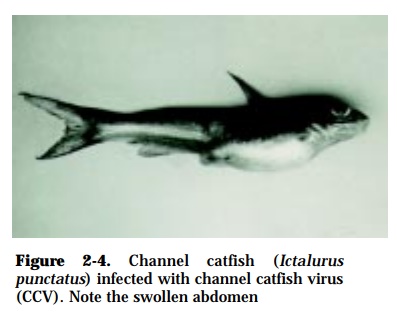Chapter: Health Management in Aquaculture: Viral diseases
Channel Catfish Virus Disease (CCVD) - Viral Infections In Fish
Channel Catfish Virus Disease (CCVD)
CAUSATIVE AGENT:
Herpesvirus ictaluri (90 to 100 nm)
SPECIES AFFECTED:
Channel catfish (Ictalurus punctatus)
GROSS SIGNS:
Acute infection of cultured channel catfish fry and fingerlings less than 10 cm long, juveniles and adults occurs following waterborne exposure to CCV. Clini-cal signs are abdominal distension (Fig. 2-4), exophthalmia, pale or hemor-rhagic gills, petecchial hemorrhage at the base of the fins and throughout the skin. In 20 to 50% of the epizootics, affected fish swim in head-high or hanging position at the surface.

EFFECT ON HOST:
Severe mortality of sometimes nearly 100% occur among young-of-the-year Ictalurus punctatus at water temperatures of 25°C or higher within 7 to 10days. It causes moderate mortalities at 21 to 24°C and almost no mortalities below 18°C. Secondary invasion of external lesions by Flavobacteriumcolumnares, Aeromonas hydrophila or aquatic phycomycetes may develop.CCVD develops into a hemorrhagic viremia after initially replicating in the kid-ney and then in the spleen. Thereafter, the virus is transported to the intestine, liver, heart, and brain. Necrosis of the renal hematopoietic tissue and tubules; edema, necrosis and congestion of the liver; intestinal edema; congestion and hemorrhage in the spleen are characteristic histopathological findings. Skeletalmuscle hemorrhage among experimentally infected fish has been observed.
Survivors of experimental CCVD averaged only two-thirds the length and one-seventh the weight of control fish 6 months after a standardized feeding regime. The portal of entry for CCV from wa-ter is through the gills and the gut. The virus can be isolated from the kidney of fish with active infections during an epizootic using CCO or BB cells, which develop CPE 24 to 48 h post exposure. Opti-mum replication was observed at 25 to 30°C. The virus is readily transmitted from fish to fish during an epizootic. In natural and experimental infections, exposed fry die within 3 days of exposure and within 7 to 10 days after the first mortality. The virus also persists in apparently healthy adult broodfish.
DIAGNOSIS:
Electron microscopy (EM), serum neutralization tests, indirect fluorescent anti-body technique, nested polymerase chain reaction (PCR) and by a channel cat-fish virus probe.
Related Topics